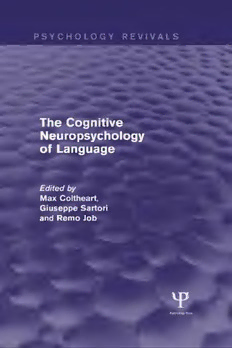Table Of ContentPSYCHOLOGY REVIVALS
The Cognitive
Neuropsychology
of Language
Edited by
Max Coltheart,
Giuseppe Sartori
and Remo Job
T
Psychology Press
Psychology Revivals
The Cognitive Neuropsychology
of Language
Damage to rhe brain can impair language in many different ways, severely
harming some linguistic functions whilst sparing others. To achieve some-
understanding of the apparently bewildering diversity of language disorders,
it is necessary to interpret impaired linguistic performance by relating it to a
model of normal linguistic performance. Originally published in 1987, this
book describes the application of such models of normal language processing
to the interpretation of a wide variety of linguistic disorders. It deals with
both the production and the comprehension of language, with language at
both the sentence and the single-word level, with written as well as with
spoken language and with acquired as well as with developmental disorders.
This page intentionally left blank
The Cognitive Neuropsychology
of Language
Edited by
Max Coltheart
Giuseppe Sartori
Remo Job
Vp Psychology Press
X Taylor & Francis Croup
LONDON AND NEW YORK
First published in 1987
by Lawrence Erlbaum Associates, Ltd
This edition first published in 2014 by Psychology Press
27 Church Road, Hove, BN3 2FA
Simultaneously published in the USA and Canada
by Psychology Press
711 Third Avenue, New York, NY 10017
Psychology Press is an imprint of tlx Taylor & Francis Group, an informa business
Copyright © 1987 by Lawrence Eribaum Associates, Ltd.
All rights reserved. No part of this book may be reprinted or reproduced or uriliscd in
any form or by any electronic, mechanical, or other means, now known or hereafter
invented, including photocopying and recording, or in any information storage or
retrieval system, without permission in writing from the publishers.
Publisher’s Note
The publisher has gone to great lengths to ensure the quality of this reprint but points
out that some imperfections in the original copies may be apparent.
Disclaimer
The publisher has made every effort to trace copyright holders and welcomes
correspondence from those they have been unable to contact.
ISBN: 978-1-84872-309-2 (hbk)
ISBN: 978-1-315-83280-7 (ebk)
THE COGNITIVE NEUROPSYCHOLOGY
OF LANGUAGE
Edited by
Max Coltheart
Giuseppe Sartori
Remo Job
f¥^/A LAWRENCEERLBAUM ASSOCIATES,PUBLISHERSnisTA
1 London Hillsdale, New Jersey llt= ^\
Copyright © 1987 by Lawrence Erlbaum Associates Ltd.
All rights reserved. No part of this book may be reproduced in
any form, by photostat, microform, retrieval system, or any other
means, without the prior written permission of the publisher.
Lawrence Erlbaum Associates Ltd., Publishers
27 Palmeira Mansions
Church Road
Hove
East Sussex BN3 2FA
Reprinted 1989
British Library Cataloguing in Publication Data
The Cognitive neuropsychology of language.
I. Neurolinguistics
I. Coltheart, M.
612.8 QP399
ISBN 0-86377-036-3
Typeset by Latimer Trend & Company Ltd., Plymouth
Printed and bound by A. Wheaton & Co. Ltd., Exeter
Contents
Preface
1. Functional Architecture of the Language-Processing System 1
Max Coltheart
Processing Single Words and Non-Words 5
Sentence Production and Comprehension 21
Conclusions 23
References 24
2. Reading Without Letters? 27
David Howard
Introduction 27
Case Report 33
Cross Case Matching 4!
The Effects of Visual Manipulations on Oral Word Reading
Script Effects in Oral Word Reading 49
Word Shape and Lexical Decision 51
Discussion 52
Acknowledgements 57
References 57
3. Direct-Route Reading and the Locus of Lexical Decision 59
Giuseppe Sartori, Jacqueline Masterson, and Remo Job
Introduction 59
Case Report 63
Experimental Investigation 64
Discussion 71
Appendices 75
References 76
4. Speech Output Processes and Reading 79
Daniel Bub, Sandra Black, Janice Howell, and Andrew Kertesz
Introduction 79
Case Report 83
Testing for Adequate Subvocal Rehearsal 95
Ability to Decode Written Sentences 101
Discussion 103
References 107
5. Impairments of Semantic Processing: Multiple Dissociations 111
Tim Shallice
Multiple Semantic Representation Systems 112
Degraded Representations and Impaired Access 117
Problems and Complications 121
References 126
6. Contrasting Patterns of Sentence Comprehension Deficits in
Aphasia 129
David Caplan
Introduction 129
Methods and Materials 130
CaseS. P. 133
CaseR. L. 139
Concluding Remarks 141
Acknowledgements 143
References 143
7. Spoken Language Comprehension in Aphasia: A Real-Time Processing
Perspective 145
Lorraine K. Tyler
Introduction 145
Selection of Patients 148
Current Research 149
Conclusions 160
Acknowledgements 161
References 162
8. Patterns of Speech Production Deficit Within and Across Aphasia
Syndromes: Application of a Psycholinguistic Model 163
Myrna F. Schwartz
Introduction 163
The Psycholinguistic Approach to Aphasia 164
The Classical Neuroanatomical Theory of the Aphasias 165
A Psycholinguistic Model of Sentence Production 177
Sentence Production in Wernicke’s Aphasia 183
Sentence Production Deficits in Agrammatic Broca’s Aphasies 189
Acknowledgements 196
References 196
vi
9. Grammatical Disturbances of Speech Production 201
Domenico Parisi
Introduction 201
The Construction of a Sentence’s Meaning 201
The Production of Content and Function Words 209
Some Data on Grammatically Disturbed Spontaneous
Speech 211
Discussion of the Data 215
References 219
10. Symptom Co-Occurrence and Dissociation in the Interpretation of
Agrammatism 221
Rita Sloan Berndt
Introduction 221
Methods 223
Discussion 230
Acknowledgements 232
References 232
11. The Role of the Phoneme-to-Grapheme Conversion System and of the
Graphemic Output Buffer in Writing 235
Gabriele Miceli, Maria Caterina Jilveri, and Alfonso Caramazza
Introduction 235
Case Report 239
Experimental Study 240
Acknowledgements 251
References 251
12. Speech and Writing Errors in “Neologistic Jargonaphasia”: A Lexical
Activation Hypothesis 253
Diane Miller and Andrew W. Ellis
Introduction 253
R.D.’s Errors in Speech and Writing 255
Interpretation and Implications 262
Acknowledgements 268
References 269
13. Speak and Spell: Dissociations and Word-Class Effects 273
Karalyn Patterson and Christina Shewell
Introduction 273
Case Report 276
Background Tests 277
Spelling 283
Word-Class Effects 285
Concluding Comments 291
References 292
vii

